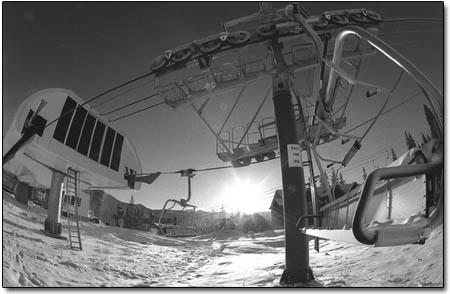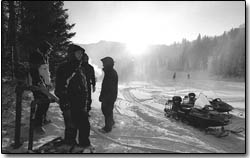|
Local ski areas work to stay competitive in flat
industry
by Will Sands
 |
| The Durango Mountain Resort
Six Pack sits idle prior to its Nov. 27 official opening.
Like many ski areas, DMR is adapting to flat skier numbers
by focusing on a quality experience and courting the younger
market with terrain parks./Photo by Ben Eng. |
The ski industry has seen better days. In recent years, drought
along with aging baby boomers, economic shortfall and travel woes
have led to flat skier numbers. However, ski areas throughout
Southwest Colorado are adapting to changing times and adjusting
their operations accordingly. This in mind, every local ski area
operator is looking to the future with optimism.
With the arrival of Thanksgiving Day, Durango Mountain Resort,
Telluride Ski Area, Wolf Creek Ski Area and Silverton Mountain
will all be open and serving skiers and snowboarders. Kristin
Rust, communications director for Colorado Ski Country USA, said
like ski areas throughout the state and nation, they will be facing
a familiar situation.
“Numbers have been flat,” she said matter of factly,
noting that the days of double-digit growth in the early 1980s
are now only a memory.
However, she stressed that the core of skiers and snowboarders
is still out there even though the dynamic may be different. “Things
are changing, and we’re focusing on the youth because of
that. We’re still very confident in our visitor,”
Rust said, noting that much of her organization’s promotion
is now related to terrain parks and snowboarding.
Rust said destination ski areas throughout the region and state
also are directing their efforts at the industry’s bread
and butter – the destination skier. “We need to pull
the destination skiers,” she said. “Those are the
people who come and spend the money.”
Keeping up with the Moritas
Durango Mountain Resort is one ski area that’s doing its
best to reach out to the destination skier. Communications Director
Matt Skinner said that the effort to put skiing back on the pedestal
is industrywide. “Everyone’s aware of the flat numbers,”
he said, citing only an average season last year for DMR which
followed the low visitation drought season of 2001-02.
For its part, DMR has put its focus on the quality of the ski
experience. “For our destination skiers, we’re trying
to keep the cost reasonable, keep the experience fun and keep
improving the resort and make sure its up to date and skier and
rider friendly,” Skinner said.
 |
| Durango Mountain Resort snowmakers
Mark Penny, Ben Louis and Jared Sargent brave low temperatures
and early morning hours to prepare the resort for opening
day./Photo by Ben Eng. |
In addition, the resort is also targeting a younger audience,
as evidenced by the creation of the new Paradise Terrain Park,
a new teenage program and more family promotions. “We spent
half a million dollars this year on upgraded rental equipment
for kids, the terrain park and a mobile restaurant which will
be placed mainly at the mountain’s backside,” Skinner
said.
He concluded that the continued upgrade of the resort hinges
on the resort’s 20-year master plan which calls for a mix
of townhomes and single-family homes totaling 1,649 units as well
as 410,000 square feet of new hotel and shop space.
“This resort development is a 20-year project,” he
said. “The idea is that by developing a few lots per year,
we’ll be able to infuse money back into the ski operation
and continue to improve it over time.”
A $14 million hand up
The Telluride Ski & Golf Resort is one resort that is done
with improvements for the time being. Three years ago, the resort
unveiled its $14 million Prospect Bowl expansion, a move that
greatly enhanced the amount of skiable acreage and primarily appealed
to the intermediate skier. Annie Carlson, communications director,
said that the expansion had one primary motive – attracting
the destination skier.
“We’re very fortunate to have seen an increase in
skiers over the last few seasons,” she said. “We opened
Prospect Bowl three years ago and that’s been a tremendous
draw. It’s going to continue to attract the destination
guest which is the resort’s bread and butter.”
Carlson said that Telluride also has worked to increase the number
of airline flights into the valley and make them more convenient
and affordable.
However, over the last six months, it also has been widely publicized
that the ski area has been partly or entirely for sale. Joe Morita,
son of the Sony Corporation’s founder, has been the sole
owner of the resort since 2001. Since that time, Morita has been
a largely absentee owner and left resort operations in the hands
of Booth Creek Ski Holdings, a Beaver Creek management team.
Last Monday, it was announced that Morita had signed a contract
to sell a portion of the Telluride Ski & Golf Resort and begin
a joint venture with the Horning Family of Newport Beach, Calif.
The deal is expected to close in 2003. Carlson said that the move
had nothing to do with financial distress, saying, “(Morita)
was trying to rebalance his global portfolio.”
And as for the $14 million price tag of Prospect Bowl, she said,
“He had the idea that it would be recouped. Obviously, it
will take some time.”
The secret to success
The Wolf Creek Ski Area takes a more down-home approach to surviving
in this day of leaner visitation. The area’s last major
capital improvement was in 2000 when it built the Alberta Lift,
one of the only fixed-grip quads in the state.
Roseanne Pitcher, director of sales and marketing, said that
with a lean marketing budget and no snowmaking equipment, the
ski area relies heavily on Mother Nature and Wolf Creek’s
reputation for having the most snow anywhere.
“The secret is having snow and nobody can control that,”
she said. “When Wolf Creek doesn’t have snow, we’re
not busy. We’ve been lucky that it doesn’t happen
that often.”
Snow report aside, Pitcher said that Wolf Creek is also focusing
on providing a quality, affordable experience to guests. “We
think we’re giving a really good value for the money spent,”
she said. “Not everybody is price sensitive, but at least
the people that are can come and have a place to ski.”
While the ski area pulls people from throughout Colorado and
New Mexico for early season, it also relies heavily on destination
skiers and is populated heavily by Texans and Oklahomans over
the holiday season. However, Pitcher added that none of them show
up when the weather is not cooperating.
“You’d like to think you get bigger every year, but
then you have that year when you get no snow,” she said.
The call of the steep
During its brief life span, Silverton Mountain has gotten bigger
every year. And though the area has been hindered by a longer-than-expected
permitting process, owner Aaron Brill said that he thinks his
bet will pay off.
“We’re seeing tremendous growth,” he said.
“It’s just been a matter of providing a quality experience
and for us, that’s good, steep skiing and quality snow conditions.”
Brill started Silverton Mountain in 2001 as an anti-resort, building
one fixed-grip, two-seat chairlift that serves only steep, expert
terrain on Storm Peak. Last week, Brill got the OK for what he
hopes will be the area’s third and final season operating
under a temporary permit. Currently, he is allowed to conduct
80 guided tours a day, a far cry from Brill’s original proposal
for 475 unguided skiers a day paying only $25 for a ski ticket.
However, he said he is hopeful that the real permit will arrive
this spring and is certain that there will be demand for Silverton
Mountain.
“The market is continually evolving,” he said. “As
the younger skiers move into their 20s and 30s and start having
expendable income, they’re also just getting better, largely
because of improved equipment.”
Brill cited solid growth for helicopter and snowcat skiing operations
at the same time resorts have posted flat skier numbers. Speaking
first hand, he said. “The only thing that’s a little
bit of a surprise is that the spectrum of people interested in
Silverton Mountain is greater than I thought it would be.”
And while many resorts are pushing for increased intermediate
terrain and a more casual ski experience, Brill offered a different
prediction. “I think areas lacking steep skiing will have
a harder time staying viable in the future,” he said.
|

